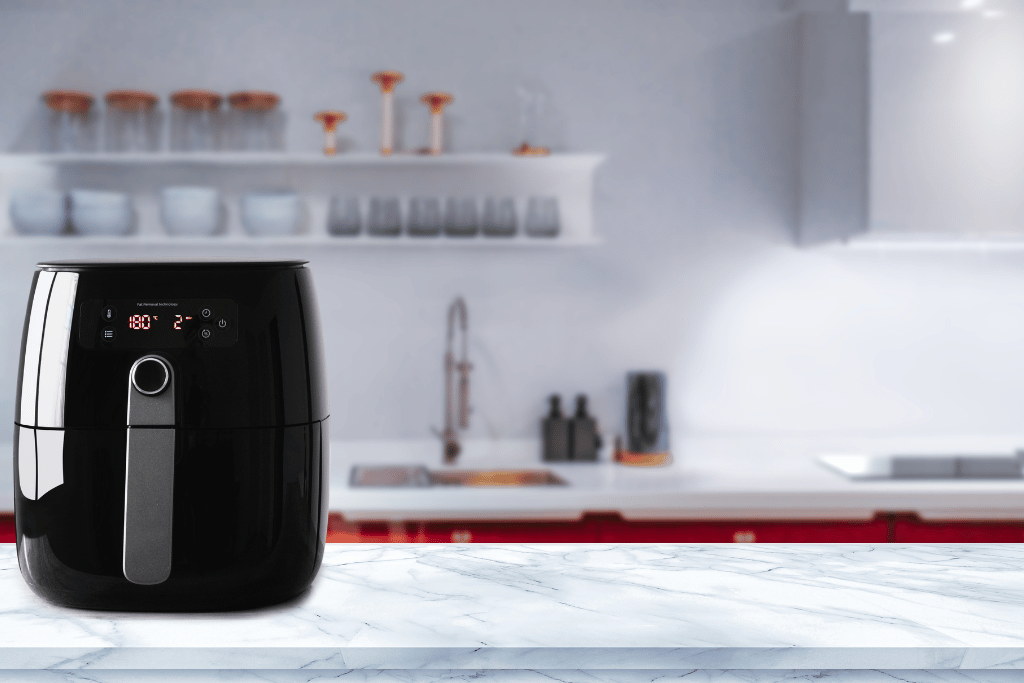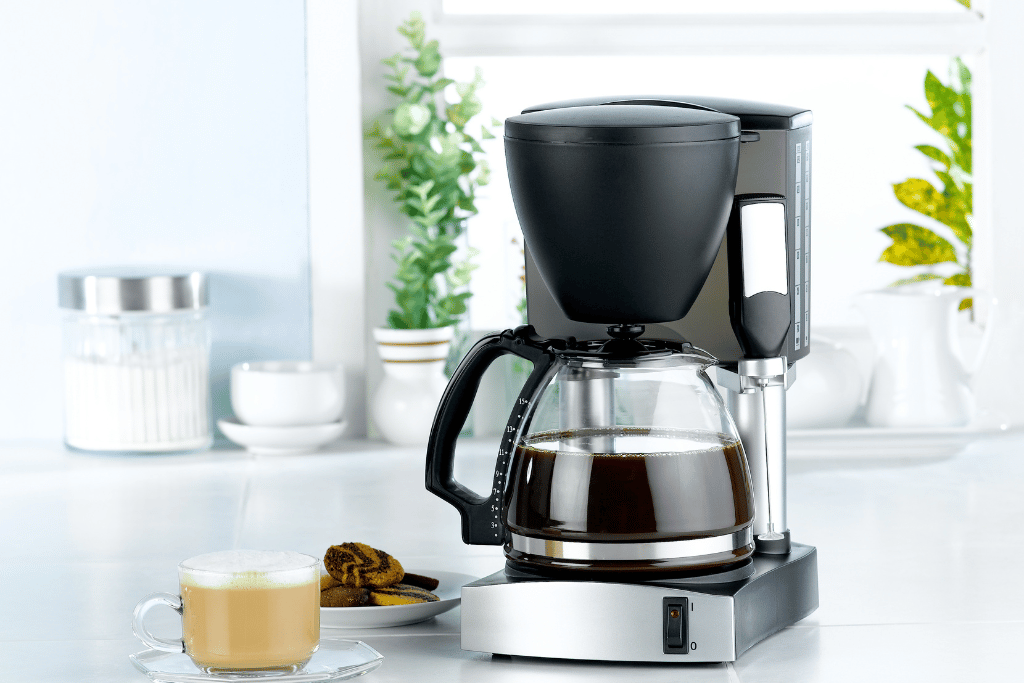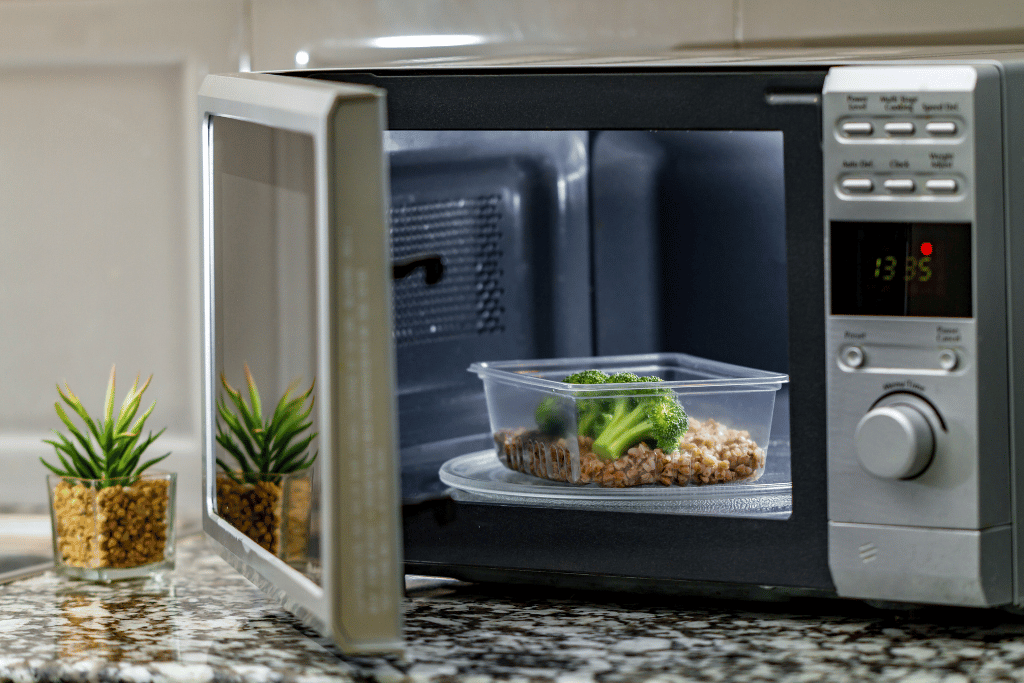Looking to stack your air fryer on a microwave? You are at the right place! I have explored the best practices! Keep reading!

Handling a small kitchen in a little house can be tricky. That’s why You need to be clever to use the kitchen space well and put your kitchen gadgets in the right places.
In the modern kitchen, where appliances like air fryers and microwave ovens have become indispensable, space is often a precious commodity. With the increasing popularity of these appliances, the question arises: “Can I put an air fryer on top of microwave?” It’s a valid concern, as finding the right spot for these kitchen gadgets can be a real puzzle.
In this article, we’ll explore the safety and practicality of stacking an air fryer on top of a microwave and guide the ideal placement for each appliance. Before you decide to create your own culinary appliance tower, let’s dive into the considerations you should keep in mind.
Can You Safely Place an Air Fryer on Top of a Microwave?
When it comes to stacking kitchen appliances, safety should be your top priority. Air fryers, known for their convenience and versatility in cooking, generate heat during operation.
Microwaves, on the other hand, also produce heat while heating food. Stacking one appliance on top of another can potentially create safety hazards. Here are some key concerns:
1. Heat:
Both air fryers and microwaves require proper ventilation to dissipate heat effectively. Placing an air fryer directly on top of a microwave might obstruct the ventilation of both appliances, causing them to overheat and potentially malfunction.
2. Weight:
Consider the weight of your air fryer. Some air fryers are relatively lightweight, while others can be quite hefty. Placing a heavy appliance on top of another could lead to structural damage or instability.
3. Safety Risks:
Stacking appliances can increase the risk of accidents. For instance, it might be challenging to access the controls or the door of the microwave with an air fryer on top of it, increasing the likelihood of spills or burns.
Given these concerns, it’s generally not advisable to stack an air fryer directly on top of a microwave. However, there are alternative solutions to consider.
Air Fryer Placement Considerations

- Counter Space: The ideal location for your air fryer is on a sturdy, flat countertop. Ensure that the surface is heat-resistant and can handle the appliance’s weight. This placement allows for proper ventilation and easy access to controls.
- Ventilation: Air fryers need adequate space around them to function efficiently. Ensure there is at least four inches of clearance on all sides of the air fryer to allow for proper airflow.
- Safety Tips: To enhance safety, keep your air fryer away from the edge of the counter to prevent accidental falls. Additionally, plug it directly into a wall outlet rather than using an extension cord.
Microwave Oven Placement Considerations
Just as proper placement is crucial for an air fryer, the same holds true for your microwave oven. Microwave ovens are convenient for reheating, defrosting, and cooking a variety of dishes. To ensure they function safely and effectively, consider the following placement considerations:
- Counter Space: Microwaves are best placed on a flat, stable countertop like air fryers. Ensure that the counter can support the weight of the microwave.
- Clearance: Microwaves, too, require proper ventilation. Leave at least three to five inches of space around the sides and back of the microwave to allow heat to dissipate. Avoid blocking the vents.
- Height: Ideally, the microwave should be at a comfortable height for easy access to the controls and the interior. Avoid placing it too high or too low, which can be inconvenient and potentially unsafe.
- Built-in Options: If you’re dealing with limited counter space, consider built-in microwave options. These can be installed into cabinets or wall units, freeing up valuable counter space.
- Power Source: Ensure your microwave is conveniently located near an electrical outlet. Using an extension cord for a microwave is generally discouraged, as it can lead to electrical issues and safety hazards.
Safety Precautions for Stacking Appliances

Safety should always be a primary concern when it comes to kitchen appliances. Here are some safety precautions to keep in mind whether you’re considering stacking appliances or placing them individually:
- Weight Limit: Be aware of your countertops’ weight limits and load-bearing capacity and shelving if you’re considering stacking appliances. Check the manufacturer’s guidelines for both your microwave and air fryer.
- Ventilation: Ensure that both your microwave and air fryer have adequate ventilation to dissipate heat effectively. Blocked vents can lead to overheating and potential malfunctions.
- Stability: If you decide to stack appliances, ensure they are stable and secure. Use anti-slip mats or appliances designed for stacking to prevent accidents.
- Safety Manuals: Always read the safety manuals that come with your appliances. Manufacturers provide specific guidelines for installation and safe usage.
- Unplug When Not in Use: When appliances are not in use, unplug them. This not only conserves energy but also eliminates the risk of accidental activation.
- Regular Maintenance: Keep your appliances clean and well-maintained. Regularly inspect cords, plugs, and outlets for signs of wear or damage.
Can You Place Other Appliances on Top of a Microwave?
Stacking appliances in the kitchen is a common space-saving strategy, but it’s essential to consider the compatibility and safety of placing other appliances on top of a microwave. Here’s a closer look at whether you can safely stack other appliances on a microwave:
Toaster Oven:
Toaster ovens are often small and lightweight, making them a more suitable candidate for stacking. However, you should still exercise caution. Ensure that the toaster oven is stable and securely placed to prevent tipping.
Coffee Maker:

Coffee makers are relatively lightweight and typically safe to place on a microwave. Just ensure that the microwave’s vents and controls are not obstructed. Always follow the manufacturer’s guidelines for stacking the gadget.
Blender:
Blenders can be heavy and may not be suitable for stacking due to their bulk and weight. It’s generally better to find a separate space for your blender to ensure safety and accessibility.
Kitchen Mixer:
Kitchen mixers, like stand mixers, are quite heavy and should not be stacked on top of a microwave. Instead, consider placing them on a dedicated countertop space.
Electric Kettle:
Electric kettles are often compact and lightweight, making them a reasonable choice for stacking. However, make sure the microwave’s ventilation is not blocked.
Rice Cooker:
Rice cookers vary in size and weight. Smaller models may be suitable for stacking, but larger ones are better placed on a separate surface. Always check the manufacturer’s recommendations.
Crock-Pot or Slow Cooker:
These appliances are typically bulkier and heavier, so avoiding stacking them on a microwave is advisable. Find a stable countertop for them.
What You Should Avoid Placing on the Surface of a Microwave
When it comes to your microwave, it’s essential to be cautious about what you place on top of it to ensure safety and functionality. Here’s a list of items you should avoid putting on top of a microwave:

- Heavy Appliances: Avoid placing heavy kitchen appliances like blenders, food processors, or stand mixers on top of your microwave. The weight can strain the microwave and potentially cause damage.
- Hot or Heat-Producing Appliances: Never put hot appliances or those that generate heat, such as toasters, toaster ovens, or coffee makers, on top of a microwave. This can obstruct the microwave’s ventilation and lead to overheating.
- Items with Liquid or Moisture: Items like potted plants or vases with water should be kept away from the microwave. Spills or leaks can damage the microwave and pose electrical hazards.
- Flammable Items: Avoid placing flammable items like paper towels, cloth, or any material that can catch fire easily on top of a microwave. Microwaves generate heat during operation, and these items can be a fire hazard.
- Electrical Cord: Don’t place appliances with electrical cords or plugs that can dangle near the microwave’s control panel or vents. This can interfere with proper ventilation and pose electrical risks.
- Unstable or Top-Heavy Objects: Avoid putting unstable or top-heavy items on the microwave, as they can fall and cause accidents. This includes tall bottles, heavy cookware, or easily tip-over items.
- Electronic Devices: Keep electronic devices like radios, speakers, or tablets away from the microwave’s immediate vicinity. The microwave’s electromagnetic radiation can interfere with electronic signals.
- Food Debris: Ensure that no food particles or debris accumulate on top of the microwave, as this can potentially fall inside and affect its performance.
- Excess Clutter: Avoid cluttering the top of the microwave with too many items. It can make the microwave harder to access and can also obstruct ventilation.
- Anything that Blocks Ventilation: The vents on a microwave are crucial for releasing heat. Never place anything that obstructs these vents, which can lead to overheating and appliance malfunction.
The Best Surfaces for Placing an Air Fryer
Selecting the right surface for placing your air fryer is crucial for both its functionality and safety. Here are some of the best surfaces to consider:
1. Heat-Resistant Countertops: Opt for heat-resistant materials such as granite, quartz, or stainless steel. These surfaces can handle the heat the air fryer generates without getting damaged. Ensure the countertop is sturdy enough to support the appliance’s weight.
2. Non-Flammable Surfaces: Choose non-flammable surfaces that won’t catch fire easily. Avoid placing the air fryer on surfaces like wooden tables or near items that can catch fire. This ensures a safe cooking environment.
3. Stable and Level Spaces: Always place the air fryer on a stable and level surface. Uneven or wobbly surfaces can lead to accidents or spills. The cooking process might also be affected if the surface isn’t level.

4. Adequate Ventilation: Ensure that the area where you place the air fryer has proper ventilation. This prevents the appliance from overheating and allows hot air to circulate effectively. Avoid enclosed spaces or placing the air fryer against a wall that might block airflow.
5. Away from Water Sources: Keep the air fryer away from water sources like sinks or faucets. Water and electrical appliances don’t mix well and can pose safety hazards.
6. Avoid Overhead Cabinets: Avoid placing the air fryer directly under overhead cabinets, especially if there’s limited clearance. The hot air expelled during cooking needs space to circulate without getting trapped.
7. Enough Space Around: Give the air fryer some breathing room. Leave enough space on all sides for proper ventilation and safe operation. This also prevents adjacent items from getting heated and potentially damaged.
8. Easy Access to Outlets: Place the air fryer near an electrical outlet. Using extension cords is not recommended, as they can create electrical risks. Plugging directly into an outlet ensures a safe power supply.
9. Anti-Slip Mats: Consider using anti-slip mats or silicone pads under the air fryer to prevent it from moving around during operation. This adds an extra layer of stability and safety.
Conclusion
In summary, where you put your air fryer matters. So, can I put an air fryer on top of the microwave? The answer is generally no. Stacking appliances can be risky, especially when they generate heat or are heavy. It’s safer to find separate spots for them. Your air fryer can go on a sturdy countertop, and your microwave needs its space too.
While some smaller, lighter kitchen appliances may be stackable on top of a microwave, exercise caution and prioritize safety. Always evaluate the compatibility, stability, and manufacturer’s guidelines to make informed decisions about appliance stacking in your kitchen.
Following proper placement and safety precautions ensures that you can enjoy the convenience of your kitchen gadgets while minimizing potential risks.
Remember, safety is vital in the kitchen. These simple guidelines will help you cook delicious meals while keeping your kitchen safe and organized.
FAQs
Can I place my air fryer on top of my microwave?
In most cases, placing an air fryer on top of a microwave is not recommended. Air fryers can generate significant heat, and microwaves require proper ventilation to dissipate heat effectively.
Can I use a microwave cart or shelf to stack them safely?
Using a microwave cart or shelf designed for kitchen appliances can be a safer option for stacking your microwave and air fryer. These carts often come with proper ventilation and are designed to support the weight of both appliances.
Can stacking appliances like this void warranties?
Yes, stacking appliances in a way that is not recommended by the manufacturer can void warranties for both appliances. It’s essential to read and adhere to the manufacturer’s user manuals and guidelines to maintain warranty coverage.
What’s the safest way to use both appliances in a small kitchen?
If you have limited counter space, consider using a dedicated kitchen cart or shelf with proper ventilation to house both appliances separately. This allows for safe and efficient operation without the risks associated with stacking.